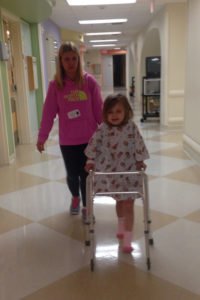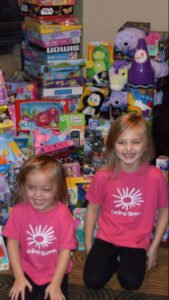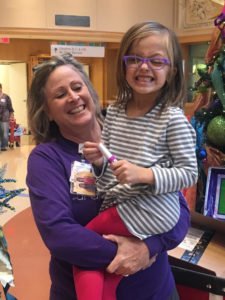Our Patients:
Hannah and Hailey Schilly

Hannah
The Schilly family of Crystal City, MO has two amazing daughters – Hannah, who is the oldest (13 as of this story), and Hailey, age 11. Hailey has been a patient at SSM Health Cardinal Glennon since she was 18 months old. Parents Heather and Tom never thought that BOTH of their girls would need the hospital in critical, life-saving ways. But on one spring day in 2015, that nightmare became real life.
On April 4, 2015, Hannah fell through a glass coffee table. The glass went through her back, puncturing her kidney, and she and her parents waited anxiously for the ambulance to arrive. Paramedics wrapped her in plastic, helping to contain the glass chards. She was transported to a local hospital in Festus, MO and a CT scan determined the need to airlift her to the nearest Level 1 Trauma Center.
Hannah’s care team in Festus had arranged the helicopter to take Hannah to an adult trauma center; however, when that plan was communicated to Heather, she refused and asserted that the helicopter take her to SSM Health Cardinal Glennon. “I couldn’t accept them taking her anywhere else but Glennon,” Heather said. I knew no matter what was going to take place, they would give her and us, as her parents – everything they had,” says Heather.
Once she arrived to the Dan Dierdorf Emergency and Trauma Center at SSM Health Cardinal Glennon, Hannah was seen by Kaveer Chattoorgoon, MD, FRCSC, FACS, FAAP, a Pediatric Surgery Specialist. As the trauma team carefully began unwrapping the layers of plastic around her torso, Hannah began vomiting and losing a lot of blood. Dr. Chatoorgoon suspected she threw a clot. Techniques such as observation or cauterization were not an option in her case. The only option to save her was to operate immediately.
Hannah recovered in the Pediatric Intensive Care Unit, and was kept in a medically-induced coma for 2 days. Her post-operative progress was excellent, despite wound vacuums and other challenges, and she was able to transfer to a general care floor within that week. Just when her family started to feel like the worst was hopefully over, Hannah developed an aneurysm and needed to return for a second surgery. Following that second surgery, her physical therapy was steady and strong, but her nutritional and emotional recovery were more challenging. Hannah refused to eat despite the consistent, supportive encouragement from her care team. Nothing from her nurses or parents could persuade her to eat. The Child Life therapists implemented goals and a reward chart with her for her attempts and successes. There was even a coveted prize of an American Girl Doll available if she met the goals set for her. Despite the time, attention and resources used, none of it was successful.
“The one person who actually won the battle of getting her to eat was Bebe, the transporter,” recalls Heather. Hannah had gotten to know Bebe from the many trips they took together to the Imaging department. The long walks from the inpatient unit to the Imaging department resulted in lots of hallway conversation and getting to know each other, Bebe learned of Hannah’s struggles and refusal to eat, and took time to have a talk with her. She called Hannah her ‘beautiful girl’ and made her promise to eat so she could get better. She stayed with Hannah for close to an hour that day – brushing her hair and making her feel special. “Hannah began eating right after that,” Heather says. “I am telling you that the people in this hospital, no matter what their role or HOW they are part of it, are amazing!” Not long after that victory, Hannah was preparing to go home.
“Initially, Hannah wouldn’t go in the basement where the accident happened. She would have panic attacks and was scared of many things made out of glass,” recalls Heather.” Eventually, Hannah was diagnosed with PTSD, and she has had the benefit of some cognitive behavioral therapy offered through Cardinal Glennon. And while she has made great strides, there are still triggers of the accident that remain with her.
“One of the greatest impacts of the accident was the bond that formed between Hannah and her surgeon. Even despite his career transition to another hospital a few years ago, they continue to stay in touch. Right before he left Cardinal Glennon, Hannah had one of her final check-ups. They talked for nearly two hours, and he gave her his medical kit that he used all throughout medical school. He knew of Hannah’s dream to become a doctor one day, and he told her he wanted her to have it and remember no matter how hard it gets, to always keep going,” says Heather. “The time that he spent with her was never rushed. He was careful, collaborative, and he always answered our questions in a clear, straightforward manner. It took him a long time to release her from clinic visits,” laughs Heather. “I think he considers “success” being able to see his patients be back to themselves and happy,” she says. “Hannah wouldn’t be alive if it wasn’t for him and Cardinal Glennon. The stars were aligned that night – and Hannah has always wanted to be a surgeon since her accident and what he did for her,“ says Heather.
Hannah has made a full physical recovery and loves being active. She plays volleyball for her Rockwood Thunder team and is a proud defensive specialist, libero and setter. She enjoys going to the lake with her family, bowling, skating and movies, and fully plans on pursuing a career as a surgeon. She keeps in touch with her surgeon to this day, and fully admits the role both he and the accident have had in her life. “I wouldn’t be alive if it weren’t for Dr. Kavi and Cardinal Glennon. I was given a second chance at life and I don’t take that for granted or make careless decisions. I still have some PTSD that I continue to work through, but I feel grateful for the opportunity to wake up each day and do that,” says Hannah. I just want to take any opportunity I can to give back what I was given and help other people.”
Hailey
“When she was 18 months old she developed a lazy eye. I knew right away what we were dealing with and where we needed to take her,” says Heather Schilly of Crystal City, MO. She is talking about her now 11-year-old daughter, Hailey, who is one of the biggest St. Louis Cardinals fans this side of the Mississippi.
“I took her to see the ophthalmologist, and he suspected she had Neurofibromatosis (NF). I already knew this was what he would tell me, because I have the same thing. Since I have the gene, there is a 1 in 2 chance that one or both of my daughters could develop it,” says Heather.
Neurofibromatosis is a genetic disorder of the nervous system. It affects how nerve cells form and grow and can cause tumors to grow on nerves. There’s currently no cure for NF. The treatment involves regular monitoring and treating any problems as they occur. Treatment can involve anything from surgery (to remove tumors and treat problems with bones) to medicine (to control secondary conditions). And while many people with NF can live a full life with careful monitoring and treatment, there’s also a risk of developing serious problems, such as certain types of cancer, that can reduce life expectancy.
Hailey had a tumor behind her eye that was rapidly growing, causing her lazy eye. The ophthalmologist made an immediate referral to the NF clinic at SSM Health Cardinal Glennon. “There was no question in my mind that I would have her treated at Cardinal Glennon. I was cared for at Glennon my whole life in that very clinic,” says Heather. “I knew they would offer her the best of everything.”
The first neurologist to see Hailey was Heather’s childhood neurologist – Dr. Thomas Geller. The options offered and available to help Hailey at that time included chemotherapy and/or surgery. Doing nothing was not a feasible option. Because she was so young, Hailey’s family and team agreed upon surgery to remove as much of the tumor as was possible. All hoped the surgery would buy Hailey time to grow in the event that chemotherapy or additional treatment was needed in the future.
Surgery was successful at making the tumor smaller. For the next several months, Hailey would follow up regularly at NF clinic with monitoring and imaging to track the growth of her tumor. “NF doesn’t really have a roadmap,” says Heather. “You have to be prepared for curveballs and whatever it throws at you. It’s hard to explain what a tumor is to a 2-year-old. We knew as she got older that the hard questions, conversations and decisions might come. We just took it day by day,” Heather says.
Hailey’s tumor grew and she had a second surgery at age 4. Though chemotherapy was still an option on the table, her parents believed they could buy her some more time. Surgeons chiseled away once more at her tumor, and successfully bought Hailey a few more years.
When Hailey was in 3rd grade, the tumor began pressing on her optic nerve. The tumor’s location posed greater surgical risk than with previous surgeries, so the team and the family discussed all of the alternate options available. A new chemotherapy option had become available that was not previously something offered to Hannah for treatment. SLUCare Physician, Pournima Navalkele, MD is a is board certified in pediatrics at SSM Health Cardinal Glennon Children’s Hospital and an Assistant Professor of Pediatrics at Saint Louis University School of Medicine. Her clinical interests include but are not limited to genetic syndromes such as Neurofibromatosis, new/relapsed/recurrent brain tumors and participating in clinical trials. The Thomas family met Dr. Navalkele, and she suggested the possibility of a new drug developed for NF patients that was part of a clinical trial. The investigational drug, called called selumetinib was currently a “compassionate use” trial. It was not yet FDA approved, but was showing great promise in shrinking large tumors in children with NF. While there were many risks and benefits to be weighed, additional surgery posed further risk to Hailey losing her eyesight. The family chose to be part of the trial, start the oral chemotherapy and hope for the best. Hailey, now age 11, remains on the drug to this day, and it has since become FDA approved.
Hailey has frequent visits to the Costas Center AND to the Dorothy and Larry Dallas Heart Center. Along with its needed effects, selumetib can cause some unwanted effects, as well. The most common side effects include vomiting, rash, abdominal pain, diarrhea, nausea, dry skin, fatigue, musculoskeletal pain, itching, mouth sores, and headache. Hailey’s check-ups involved monitoring and management of these more common reactions, but also the less common adverse reactions. Her visits included physical exams, bloodwork, and many other tests such as X-ray’s, MRI’s, EKG’s, echocardiograms and more. “Hailey’s had some cardiomyopathy and a decrease in her ejection fraction over time. The heart is a muscle, so any weakness of that muscle makes it harder for the heart to deliver blood to the body. They adjust her chemotherapy dose accordingly, and keep tabs on her symptoms and progress,” Heather says.
“Visits to Cardinal Glennon are kind of like visiting your second home,” says Heather. “No one is a stranger, and we definitely have people there we consider family,” Heather says. “Nurse Barb in The Dallas Heart Center, Nurse Brittanie in The Costas Center, Nurse Julie in NF clinic – they are our heroes. They spoil Hailey rotten and the right “things” are all in place for them to help her. Child Life will have IPAD’s to distract her for her IV sticks. They do medical play with her, help her through her procedures, recognize her hard work with prizes from the toy closet and so much more. The rooms in the sedation recovery area are quiet and private. The Dallas Heart Center has all of her testing equipment all there within the center. If we have to be there a lot (and we do!), it’s hard to think of anything that would make it better for her,” Heather says.
Though Hailey spends plenty of time at the hospital; her family and friends know her as a loving little sister to older sister, Hannah and as a smart and sassy 5th grader. She loves golf, hockey. St. Louis Cardinals baseball games and her dog, Maverick. Her favorite TV show is Little House On The Prairie, and she enjoys steak, corn on the cob, and McDonald’s as some of her favorite foods. Hailey hopes to be a Kindergarten teacher when she grows up, and her favorite song, appropriately so, is “Don’t Stop Believin’”.
We certainly don’t know what curveballs lay ahead for her, but I would drive hundreds of miles if we had to in order to have her care at Glennon. You won’t find better care anywhere,” Heather says. “We started an annual toy drive for the hospital several years ago as a way to give back, and we will take any opportunity we can to help to support the people that have been and continue to be here for our family,” Heather says.









